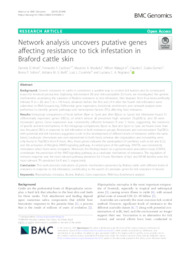Network analysis uncovers putative genes affecting resistance to tick infestation in Braford cattle skin.
Network analysis uncovers putative genes affecting resistance to tick infestation in Braford cattle skin.
Author(s): MORÉ, D. D.; CARDOSO, F. F.; MUDADU, M. de A.; MALAGO JUNIOR, W.; GULIAS GOMES, C. C.; SOLLERO, B. P.; IBELLI, A. M. G.; COUTINHO, L. L.; REGITANO, L. C. de A.
Summary: Background: Genetic resistance in cattle is considered a suitable way to control tick burden and its consequent losses for livestock production. Exploring tick-resistant (R) and tick-susceptible (S) hosts, we investigated the genetic mechanisms underlying the variation of Braford resistance to tick infestation. Skin biopsies from four-times-artificially infested R (n = 20) and S (n = 19) hosts, obtained before the first and 24 h after the fourth tick infestation were submitted to RNA-Sequencing. Differential gene expression, functional enrichment, and network analysis were performed to identify genetic pathways and transcription factors (TFs) affecting host resistance. Results: Intergroup comparisons of hosts before (Rpre vs. Spre) and after (Rpost vs. Spost) tick infestation found 51 differentially expressed genes (DEGs), of which almost all presented high variation (TopDEGs), and 38 were redundant genes. Gene expression was consistently different between R and S hosts, suggesting the existence of specific anti-tick mechanisms. In the intragroup comparisons, Rpost vs. Rpre and Spost vs. Spre, we found more than two thousand DEGs in response to tick infestation in both resistance groups. Redundant and non-redundant TopDEGs with potential anti-tick functions suggested a role in the development of different levels of resistance within the same breed. Leukocyte chemotaxis was over-represented in both hosts, whereas skin degradation and remodeling were only found in TopDEGs from R hosts. Also, these genes indicated the participation of cytokines, such as IL6 and IL22, and the activation of Wingless (WNT)-signaling pathway. A central gene of this pathway, WNT7A, was consistently modulated when hosts were compared. Moreover, the findings based on a genome-wide association study (GWAS) corroborate the prediction of the WNT-signaling pathway as a candidate mechanism of resistance. The regulation of immune response was the most relevant pathway predicted for S hosts. Members of Ap1 and NF-kB families were the most relevant TFs predicted for R and S, respectively. Conclusion: This work provides indications of genetic mechanisms presented by Braford cattle with different levels of resistance in response to tick infestation, contributing to the search of candidate genes for tick resistance in bovine.
Publication year: 2019
Types of publication: Journal article
Observation
Some of Embrapa's publications are published as ePub files. To read them, use or download one of the following free software options to your computer or mobile device. Android: Google Play Books; IOS: iBooks; Windows and Linux: Calibre.
Access other publications
Access the Agricultural Research Database (BDPA) to consult Embrapa's full library collection and records.
Visit Embrapa Bookstore to purchase books and other publications sold by Embrapa.

